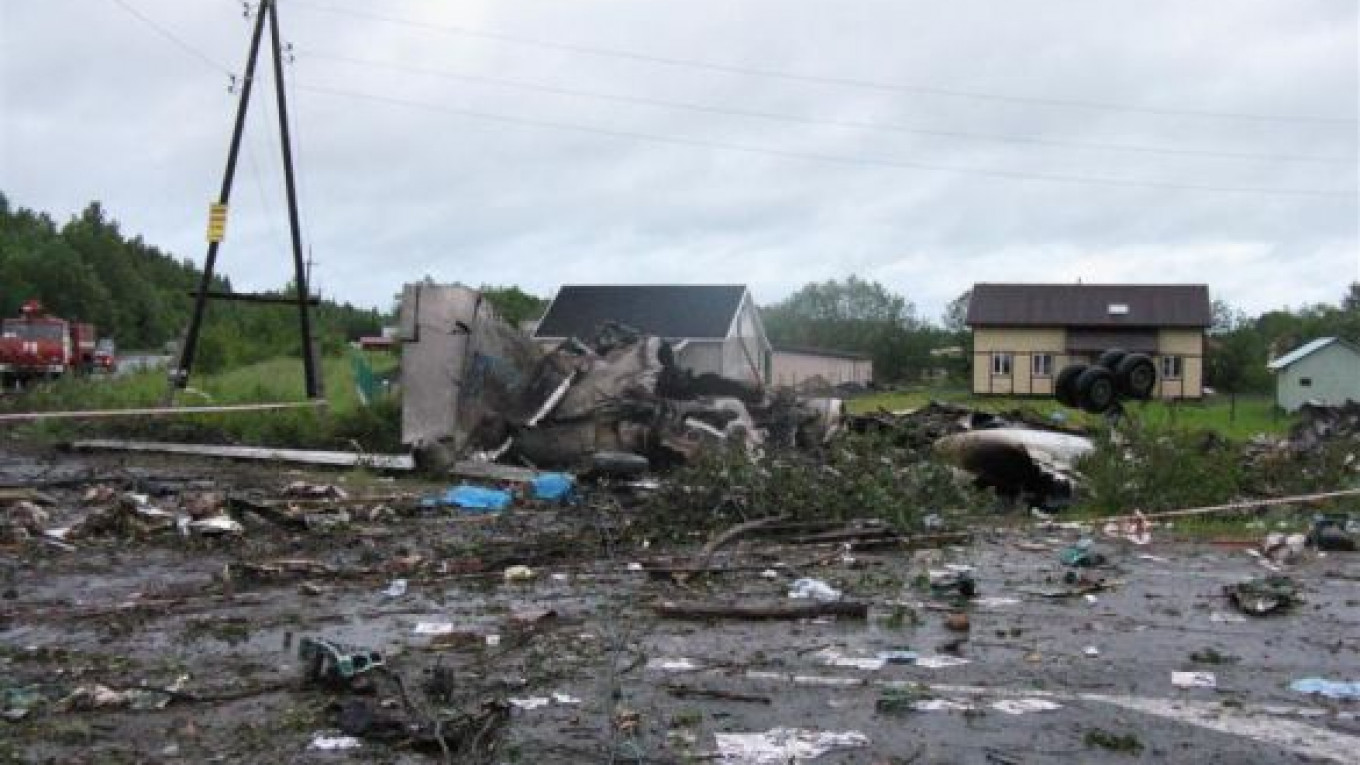ST. PETERSBURG — A Russian airliner crashed in heavy fog and burst into flames just short of a runway in northwestern Russia, killing 44 people, officials said. Eight people survived, dragged from the burning wreckage by locals.
The RusAir Tu-134 plane had taken off from Moscow and was moments from landing at the Petrozavodsk airport when it slammed into a nearby highway just before midnight Monday, Emergencies Ministry spokeswoman Oksana Semyonova told The Associated Press.
The plane's approach was too low, so it clipped a tree and then hit a high-power line — causing the airport's runway lights to go off for 10 seconds — before slamming into the ground, Sergei Izvolsky, a spokesman for the Russian air transport agency, told the AP.
Petrozavodsk is in Karelia province near the Finnish border, about 400 miles (640 kilometers) northwest of Moscow. The plane crashed about 100 meters (yards) from a small village, but no casualties were reported on the ground.
The federal air transport agency chief, Alexander Neradko, speaking from the crash site, said that preliminary information indicated the plane appeared to be intact when hit a 15-meter (49-foot) pine tree. "There is no sign of a fire or explosion on board the plane before the impact," he said.
Sergei Shmatkov, an air traffic controller who oversaw the plane's approach, was quoted by the lifenews.ru online newspaper as saying the visibility near the airport was close to the minimum admissible level at the time of the crash, but the pilot still decided to land.
"The crew continued their descent at a moment when they already should have begun a second run," he was quoted as saying.
RusAir said the plane was in good working order.
The Tu-134, along with its larger sibling the Tu-154, has been the workhorse of Soviet and Russian civil aviation since the 1960s with more than 800 planes built. The model that crashed was built in 1980, had a capacity of 68 people and a range of about 2,000 kilometers (1,240 miles).
"There is a strict rule — if you are on a glide path and you have not made a reliable eye contact with lights on the ground, there is no choice but to put engines at full throttle and make another run," said Oleg Smirnov, a former deputy civil aviation minister during Soviet times who now heads the nonprofit Partner of Civil Aviation Foundation.
"The human factor is always key, especially now when the level of crew training is very low and not controlled by the government," Tolboyev said, according to the Interfax news agency.
Video footage showed charred plane fragments, including engines and landing gear, strewn around the highway less than one kilometer (about half a mile) short of the runway. Amateur video showed the plane consumed by fierce flames in the dark night.
The plane was carrying 52 people, including nine crew members, according to the Emergencies Ministry. Four of the dead had dual U.S. and Russian citizenship — Lyudmila Simanova, Alexander Simanov, Yelizaveta Simanova and Yekaterina Simanov. The U.S. Embassy had no immediate information on them.
The official list of victims included a Swedish citizen, a Dutchman, two Ukrainians and Russian Premier League soccer referee Vladimir Pettay. The German Foreign Ministry said one victim had dual Russian-German citizenship, but didn't identify him.
The Karelia branch of the Emergencies Ministry said radio contact with the pilot was lost at 11:40 p.m. local time. The plane's flight data recorders have been recovered.
Russian President Dmitry Medvedev and Prime Minister Vladimir Putin offered condolences to the victims' families, and the nation's transport minister flew to the crash site to oversee the investigation. Putin was attending the Paris Air Show on Tuesday to support dozens of Russian firms seeking sales contracts.
In recent years, Russia and the other former Soviet republics have had some of the world's worst air traffic safety records, according to official statistics. Experts blame the poor safety record on the age of aircraft used, weak government controls, poor pilot training and a cost-cutting mentality.
Polish President Lech Kaczynski was among 96 people killed when his Tu-154 crashed in heavy fog while trying to land near the western Russian city of Smolensk in April 2010.
In 2006, three crashes - two in Russia and one in Ukraine - killed more than 400 people.
The International Air Transport Association noted that Russia has recently made progress on air safety, with none of Russia's 13 largest air carriers suffering a deadly accident over the past three years.
A Message from The Moscow Times:
Dear readers,
We are facing unprecedented challenges. Russia's Prosecutor General's Office has designated The Moscow Times as an "undesirable" organization, criminalizing our work and putting our staff at risk of prosecution. This follows our earlier unjust labeling as a "foreign agent."
These actions are direct attempts to silence independent journalism in Russia. The authorities claim our work "discredits the decisions of the Russian leadership." We see things differently: we strive to provide accurate, unbiased reporting on Russia.
We, the journalists of The Moscow Times, refuse to be silenced. But to continue our work, we need your help.
Your support, no matter how small, makes a world of difference. If you can, please support us monthly starting from just $2. It's quick to set up, and every contribution makes a significant impact.
By supporting The Moscow Times, you're defending open, independent journalism in the face of repression. Thank you for standing with us.
Remind me later.






